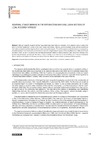Identificador persistente para citar o vincular este elemento:
https://accedacris.ulpgc.es/jspui/handle/10553/58592
| Campo DC | Valor | idioma |
|---|---|---|
| dc.contributor.author | Adams, Heather | en_US |
| dc.contributor.author | Quintana Toledo, Elena | en_US |
| dc.date.accessioned | 2019-12-16T18:20:44Z | - |
| dc.date.available | 2019-12-16T18:20:44Z | - |
| dc.date.issued | 2013 | en_US |
| dc.identifier.issn | 1886-2438 | en_US |
| dc.identifier.other | Dialnet | |
| dc.identifier.uri | https://accedacris.ulpgc.es/handle/10553/58592 | - |
| dc.description.abstract | Although scientific research articles have traditionally been taken as examples of an objective style of writing that aims to minimise researchers voices in their texts (Gilbert and Mulkay, 1984:42), authors inevitably adopt stances towards the information presented and the target audience when writing their papers. This article explores authorial stance as expressed by adverbial markers in the introduction and conclusion sections of legal research papers. Following Biber et al. (1999), and Conrad and Biber (1999), our aim is to identify the most frequent adverbial markers of stance present in each section as indicators of (i) epistemicity, (ii) attitude, and (iii) style. We will try to show whether or not there are functional differences in the use of adverbial stance markers, and whether or not these are derived from the different communicative purposes of these sections. | en_US |
| dc.language | eng | en_US |
| dc.relation.ispartof | Revista de Linguistica y Lenguas Aplicadas | en_US |
| dc.source | Revista de lingüística y lenguas aplicadas [ISSN 1886-2438] (8), p. 13-22 | en_US |
| dc.subject | 57 Lingüística | en_US |
| dc.subject.other | Adverbial stance markers | en_US |
| dc.subject.other | Attitude | en_US |
| dc.subject.other | Epistemic | en_US |
| dc.subject.other | Style | en_US |
| dc.subject.other | Introduction | en_US |
| dc.subject.other | Conclusion | en_US |
| dc.subject.other | Research article | en_US |
| dc.title | Adverbial stance marking in the introduction and conclusion sections of legal research articles | en_US |
| dc.type | info:eu-repo/semantics/Article | en_US |
| dc.type | Article | en_US |
| dc.identifier.doi | 10.4995/rlyla.2013.1028 | |
| dc.identifier.isi | 000214565800002 | |
| dc.identifier.url | http://dialnet.unirioja.es/servlet/articulo?codigo=4777902 | - |
| dc.description.lastpage | 22 | - |
| dc.identifier.issue | 8 | - |
| dc.description.firstpage | 13 | - |
| dc.investigacion | Artes y Humanidades | en_US |
| dc.type2 | Artículo | en_US |
| dc.contributor.daisngid | 2220366 | |
| dc.contributor.daisngid | 12503146 | |
| dc.contributor.authordialnetid | 1390116 | - |
| dc.contributor.authordialnetid | 2998076 | - |
| dc.identifier.dialnet | 4777902ARTREV | - |
| dc.contributor.wosstandard | WOS:Adams, H | |
| dc.contributor.wosstandard | WOS:Quintana-Toledo, E | |
| dc.date.coverdate | 2013 | |
| dc.identifier.ulpgc | Sí | es |
| dc.description.sellofecyt | Sello FECYT | |
| dc.description.esci | ESCI | |
| dc.description.dialnetimpact | 0,0 | |
| dc.description.dialnetq | Q2 | |
| dc.description.erihplus | ERIH PLUS | |
| item.grantfulltext | open | - |
| item.fulltext | Con texto completo | - |
| crisitem.author.dept | GIR IDETIC: División de Traducción e Interpretación y Aprendizaje de Lenguas | - |
| crisitem.author.dept | IU para el Desarrollo Tecnológico y la Innovación | - |
| crisitem.author.dept | Departamento de Filología Moderna, Traducción e Interpretación | - |
| crisitem.author.dept | GIR Discourse, Communication and Society | - |
| crisitem.author.dept | Departamento de Filología Moderna, Traducción e Interpretación | - |
| crisitem.author.orcid | 0000-0001-7822-431X | - |
| crisitem.author.orcid | 0000-0002-1583-808X | - |
| crisitem.author.parentorg | IU para el Desarrollo Tecnológico y la Innovación | - |
| crisitem.author.parentorg | Departamento de Filología Moderna, Traducción e Interpretación | - |
| crisitem.author.fullName | Adams, Heather Mary | - |
| crisitem.author.fullName | Quintana Toledo, Elena | - |
| Colección: | Artículos | |
Citas de WEB OF SCIENCETM
Citations
9
actualizado el 30-mar-2025
Visitas
216
actualizado el 05-oct-2024
Descargas
163
actualizado el 05-oct-2024
Google ScholarTM
Verifica
Altmetric
Comparte
Exporta metadatos
Los elementos en ULPGC accedaCRIS están protegidos por derechos de autor con todos los derechos reservados, a menos que se indique lo contrario.
